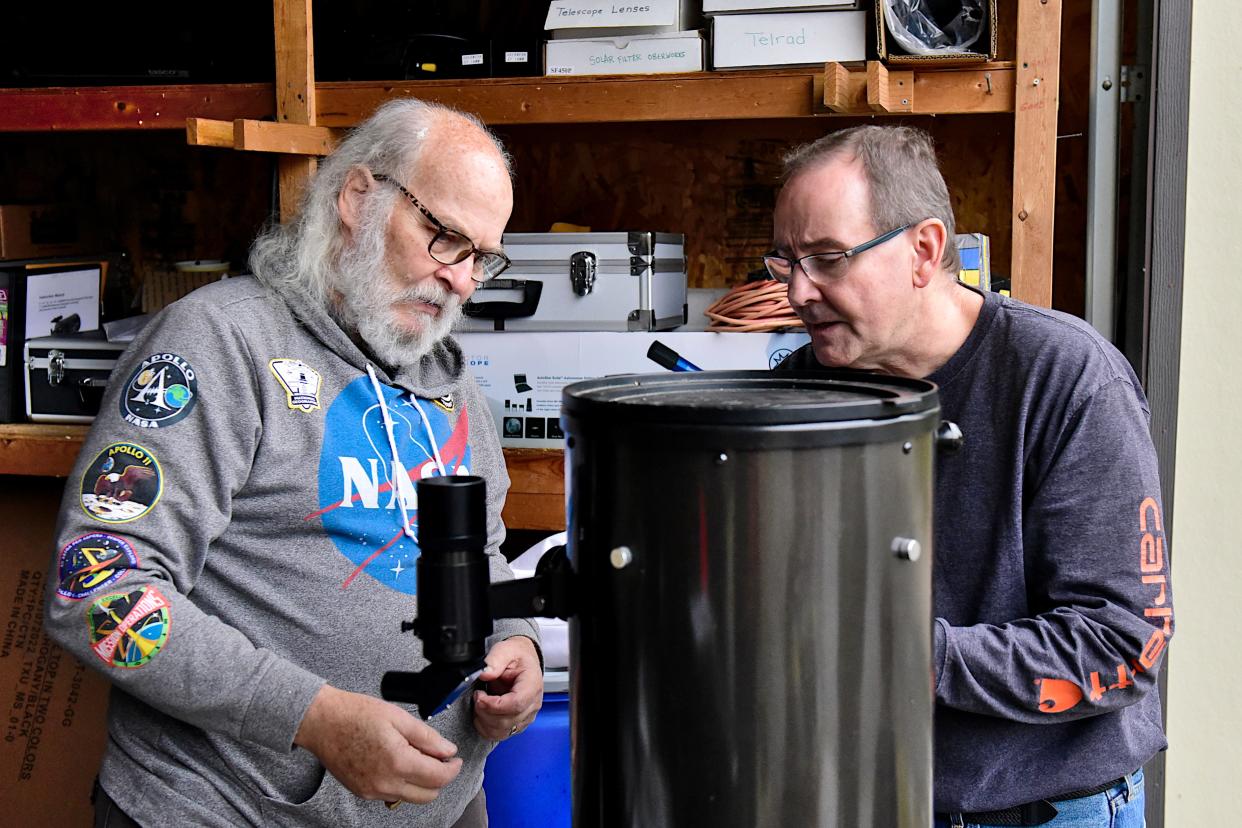'Oh, come on!': Saturday offers glimpse of what weather could be like during total eclipse

A haze of clouds kept Ohioans from seeing the partial solar eclipse over the weekend, a foreboding hint of what could unfold during the April 8, 2024, total solar eclipse.
The centerline of Saturday's annular eclipse traveled from Oregon to Texas — the moon's position allowed only about 35% of the sun in the Buckeye State to be covered, but even that was rendered invisible statewide by a weekend storm.
Ohio astronomers hoping to enjoy their serving of the eclipse found themselves instead hiding from the rain as the moment of maximum sun blockage came and went, unseen from the ground.
"Oh, come on!" Dan Everly, one of the state's premier stargazers, shouted from a park in North Central Ohio. "This is the ultimate game of hide-and-go-seek!"
Eclipses are visible to only a portion of Earth's population
A solar eclipse is visible on Earth when the moon passes between our planet and the sun and creates a shadow, Bryan Summer of the Crawford Park Astronomy Club explained Saturday to families waiting to watch the celestial event at Lowe-Volk Park near Galion.
He told them the moon's shadow is about 124 miles wide during each eclipse. That shadow, as it passes across Earth, is called the centerline of the eclipse.
People outside the centerline will see only a partial eclipse. The further the viewer is away from the shadow's path, the less of an eclipse they can see.
"Some people won't see anything at all," Summer explained. "If you're outside the zone, it will just be a normal day to you."
What's the forecast for the total solar eclipse?
Clear skies are not a guarantee in Ohio for April's total solar eclipse, explained Patrick Saunders, a meteorologist who works in the Cleveland office of the National Weather Service.
"We’ve had it all on that date," he explained.
Data collected over the years at the Mansfield Lahm Regional Airport paint a confusing picture for those attempting to guess what to expect next year.
The average high temperature for April 8 is 57 degrees. The average low is 36.
"The record highest temperature is 81," Saunders said. "That actually just happened two years ago, in 2021."
The record low of 15 degrees was set in 1982.
The weather service has no records of visibility, but meteorologists do track precipitation levels, which are often a good indication of whether there was cloud cover that day.
In 2015, a record 1.48 inches of rain fell on April 8. In 1974, there was a record 2.1 inches of snow.
"In 1987, there was 13 inches of snow on April 4 and April 5," Saunders said. "That's only a few days before April 8."
Since April is considered a transitional weather month between spring and summer, there's no telling what might happen this week next year.
"It could be 80 and hot or it could be a snowstorm," Saunders said. "There's a wide range of possibilities in April."
When and where can I see the total solar eclipse?
The April 8, 2024, eclipse will enter western Ohio about 3:10 p.m. near the city of Greenville in Darke County, according to a NASA map.
The path of the eclipse will travel northeast, reaching Cleveland by 3:15 p.m., then Erie, Pennsylvania, by about 3:18 p.m. Viewers will see the eclipse for nearly four minutes.
"Areas in Ohio that are outside the path of totality will experience a partial eclipse," the website reads.
Within the band are Marion, Bucyrus, Mansfield, Ashland, Fremont, Wooster and Akron. Just outside the area of totality are Cincinnati, Columbus and Canton.
The apex of the centerline will be in Forest, a village 35 miles west of Bucyrus in Wyandot County. Several NASA representatives are expected to be stationed beneath the apex.
'Nothing really changes on the moon'
The moon itself isn't quite a perfect circle in the sky, either. Earth's natural satellite is imperfect around the edges, which may slightly be visible to viewers of the April 8, 2024, total solar eclipse.
Summer, a retired teacher, taught children Saturday that the moon has given scientists many clues about Earth's history.
He explained that the whiter portion's of the lunar surface were formed "millions and millions of years ago," well before the shaded areas on the moon's face.
"The dark portions are actually ancient lava fields," Summer said.
The countless craters across the lunar surface offer a preserved glimpse into the history of our solar system.
On Earth, cosmic impacts are worn away by wind and rain. On the moon, the lack of weather allows the dust particles to stay put for millennia.
"Nothing really changes on the moon," Summer said.
Even traces of the Apollo astronauts who walked on the moon's surface from 1969 to 1972 would seem as fresh as though the visits were yesterday.
"If we went to the moon today, their footprints would be as perfect as they were 50 years ago," Summer said. "There's nothing on the moon to wash them away."
ztuggle@gannett.com
419-564-3508
This article originally appeared on Mansfield News Journal: Total solar eclipse could be cloudy based on Ohio's weather forecast

